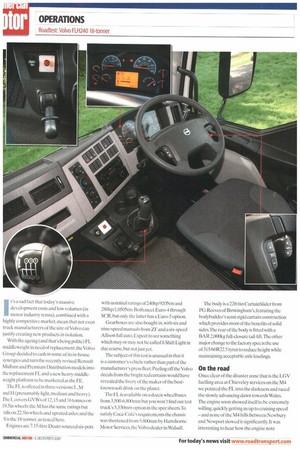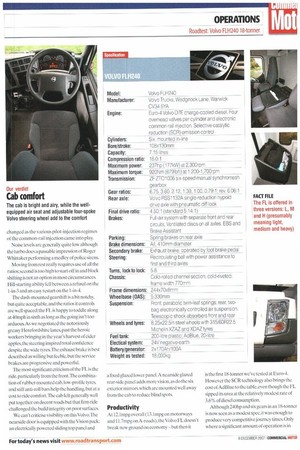I t's a sad fact that today's massive development costs and
Page 44

Page 45

Page 46

If you've noticed an error in this article please click here to report it so we can fix it.
low volumes (in motor industry terms), combined with a highly competitive market mean that not even truck manufacturers of the size of Volvo can justify creating new products in isolation.
With the ageing (and that's being polite) FL middleweight in need of replacement, the Volvo Group decided to cash in sonic of its in-house synergies and turn the recently revised Renault Midlum and Premium Distribution models into the replacement FL and a new heavy-middleweight platform to be marketed as the FE.
The FL is offered in three versions: L, M Find H (presumably light, medium and heavy). The 1. covers GVWs of 12,15 and 16 tonnes on [9.5in wheels;the M has the same ratings but -oils on 22.5in wheels and uprated axles; and the HI is the 18-tonner. as tested here.
Engines are 7.15-litre Deutz-sourced six-pots with nominal ratings of 240hp/920Nm and 280hp/1,050Nm. Both meet Euro-4 through SCR, but only the latter has a Euro-5 option.
Gearboxes are also bought in,with six and nine-speed manuals from ZF and a six-speed Allison full auto. Expect to see something which may or may not be cal I edl-Shift Light in due course,but not just yet.
The subject of this test is unusual in that it is a customer's vehicle rather than part of the manufacturer's press fleet Peeling off the Volvo decals from the bright red curtains would have revealed the livery of the maker of the bestknown soft drink on the planet.
The FL is available on a dozen wheelb&ses from 3,500-6,800mm but you won't find our test truck's 5,330mm option in the spec sheets.To satisfy Coca-Cola's requirements the chassis was shortened from 5,800mm by Hartshorne Motor Services, the Volvo dealer in Walsall. The body is a 22ft 6in CurtainSlider from PG Reeves of Birmingham's, featuring the bodybuilder's semi-rigid curtain construction which provides most of the benefits of solid sides.The rear of the body is fitted with a BAR 2,000kg full-closure tail-lift.The other major change to the factory spec is the use of 315/60R22.5 tyres to reduce height while maintaining acceptable axle loadings.
On the road Once clear of the disaster zone that is the LOV fuelling area at Chieveley services on the M4 we pointed the FL into the darkness and raced the slowly advancing dawn towards Wales. The engine soon showed itself to be extremely willing, quickly getting us up to cruising speed — and none of the M4 hills between Newbury and Newport slowed it significantly. It was interesting to hear how the engine note changed as the various pilot-injection regimes of the common-rail injection came into play.
Noise levels are generally quite low although the turbo does a passable impression of Roger Whittaker performing a medley of police sirens.
Moving from rest really requires use of all the ratios; second is too high to start off in and block shifting is not an option in most circumstances. Hill-starting ability fell between a refusal on the 1-in-3 and an easy restart on the 1-in-4.
The dash-mounted gearshift is a bit notchy, but quite acceptable. and the ratios it controls are well spaced:the FL is happy to toddle along at 40mph in sixth as long as the going isn't too arduous.As we negotiated the notoriously greasy Herefordshire lanes, past the heroic workers bringing in the year's harvest of cider apples, the steering inspired total confidence despite the wide tyres. The exhaust brake is best described as willing but feeble, but the service brakes are progressive and powerful.
The most significant criticism of the FL is the ride, particularly from the front.The combination of rubber-mounted cab,low-profile tyres, and stiff anti-roll bars help the handling, but at a cost to ride comfort.The cab felt generally well put together on decent roads but that firm ride challenged the build integrity on poor surfaces.
We can't criticise visibility on this Volvo.The nearside door is equipped with the Vision pack: an electrically powered sliding top panel and a fixed glazed lower panel.A nearside glazed rear-side panel adds more vision, as do the six exterior mirrors, which are mounted well away from the cab to reduce blind spots.
Productivity
At 12.1mpg overall (13.1mpg on motorways and 11.7mpg on A-roads), the Volvo FL doesn't break new ground on economy — but then it is the first 18-tonner we've tested at Euro-4. However the SCR technology also brings the cost of AdBlue to the table, even though the FL sipped its urea at the relatively modest rate of 3.6% of diesel consumption.
Although 240hp and six gears in an 18-tonner is now seen as a modest spec,it was enough to produce very competitive journey times. Only where a significant amount of operation is in tough, hilly terrain would the extra expense of 280hp and/or nine ratios be cost-effective.
While there are a few aspects of this Volvo's spec that are very specific to its operator, the resulting body/payload allowance still comes out at a highly competitive 12,355 kg. One small extra payload expense is the AdBlue system. which claims 22kg.
Cab comfort
Although it's not exactly low-mounted, a couple of well-placed steps and a wide opening door ensure that cab access will present no hardships to the multi-drop driver who will, by the time you read this, be driving it around Scotland.All that glass creates a bright and airy environment, though the air-con might get a good workout should the sun ever reappear.
Light grey trim panels contrast with a mainly black dash assembly and blue/grey pinstripe cloth trim to good effect.The driver gets a wellequipped air scat with integral belts as standard, while in this example the passenger side has a dual seat to the customer's requirements.
One dubious trait imported from Renault is the fixed mounting for the outer passenger's seat-belt it's too high and looks ready to provide a good garrotting in case of an accident. This is all the more disappointing when you note that the central passenger is cossetted by a full inertia belt mounted on the rear wall.
The back of the central seat folds down to provide a table and three cup-holders. Despite the dual passenger seat, there's still a good foot of space between it and the driving seat, preventing any claustrophobic feelings.
The extended day cab also gives a useful amount of storage space, including a large bin behind the passengers and a smaller one behind the drive rrlhe rear cab wall is home to a coat rail large enough to start a small charity shop.
It's easy to get comfortable with the adjustable four-spoke Volvo steering wheel, which sports a horn pad and cruise-control buttons but no air bag.The parking brake lever is conveniently located next to the gear lever.
The steering column is a busy placelhe right-hand stalk controls the wipers and driver information panel:there are two stalks to the left.One of these controls the two-position engine brake; the other carries (another) horn control plus light and indicator switches.The master lighting switch is a rotary end to the stalk, which on one early occasion plunged us into darkness as we attempted to use the indicators.
The clearly laid-out dash features lots of dials including the usual road and engine speed, comprehensive driver information display/trip computer, turbo boost, oil pressure, water temperature and two air gauges.
There is a bank of 16 switch positions to the left of the dash,but only hazard lights,hill hold, trac tion control override and difflock are used. Beneath these are the CD-radio and Dynaileet unit; to the left are a stack of rotary heater controls. Four fresh-air vents are provided but the central pair are offset to the left,far from the driver.
Above the screen are deep bins with netted open fronts to the left and centre. On the right is a VisionTechniques6OTHN reversing monitor next to the digitach and seven more switch positions, occupied here by a central locking switch and reversing alarm override. Other dash storage includes an open bin low down and a rubber-lined shelf on top.
Auxiliary power comes from a cigar lighter next to two cup-holders and an ashtray in front of the gearlever, and a couple of DIN sockets (rated at 12V/10A and 24V/I5A).The integrated look of the interior is only marred by the tail-lift isolator switch on a scrappy looking metal plate. •


























































































































































































